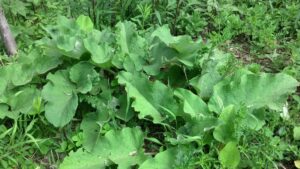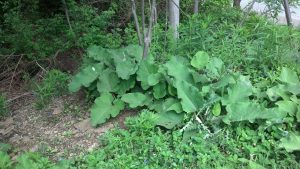
What would it be like if you had a garden that yielded abundant food but required no care? What if the vegetables it offered were loaded with nutrition, and you didn’t even need to pull weeds around it or feed it compost?
Sound too good to be true? Au contraire! In the spring, I rarely buy any vegetables and instead meander over to my beloved patch of burdock.
As Italian-Americans, we called them cardoons.
They can also be found in Italian markets and upscale food stores specializing in exotic produce, but for me, the best place to find them is in the wild.
Aren’t burdocks a weed, you may ask? Why do I want to eat weeds?
Because this is a good weed! The burdock root has been used for centuries as a “blood purifier” to clear the lungs, kidneys and bloodstream of toxins. It is also used as a diuretic and as a topical remedy for skin problems such as eczema, acne, hives, rosacea and psoriasis. Burdock root is also said to aid digestion by stimulating the production of bile in the liver.
In the spring, just after the lilacs bloom, the burdock shows itself in full bloom. This is the best time to harvest them before the stems become bitter and tough and before the root gets too woody.
We lived in the city when I was growing up, so we didn’t have burdock growing nearby. A trip to the country was in order every late spring to harvest our favorite vegetable.
Cardoons thrive in disturbed soil.
This means that the best patches were found near railroad tracks and abandoned buildings. Finding a patch that wasn’t tainted by unclean soil was important … not too close to the road, not near railroad ties and far enough away from buildings that might have been painted with lead.

Once we discovered a good patch, we’d return year after year. We considered it our cardoon patch, and although it was often on abandoned land, we felt it belonged to us.
When we got home with a carload of stems, everyone joined in the kitchen for the cleaning process. I have memories of doing this with as many as ten of us, making a mess in the kitchen, laughing and loving that we got all this good food without having stepped into a grocery store. To this day, it makes me feel freer that I can produce such a meal independent of the conventional store-bought process. It’s a meal I can “get away with,” and I love that.
After harvesting the stems, we scrubbed and cut them into bite-sized pieces, pulling off the strings when apparent, and placed them in a pot with just enough water to steam them until fork tender.
Today, I save the juice to drink later. It’s a reputed tonic, strong and to my palate, very tasty.

Then I strain the stems and dredge them in a raw egg bath, followed by flouring them with wheat flour or almond flour, salt, pepper and sometimes garlic. I love them best fried in lard or tallow in a very hot frying pan. The deeper the oil and hotter the pan, the more crispy the results. Oh, yum!
Today I live in the country where my cardoon patch is on an old, out-of-use driveway in the back of our property. After harvesting a big basketful, I visit my garlic patch, followed by a trip to our chicken coop for a few eggs and head to the house.
I fry these delights in my homemade lard that I rendered from the fat my farmer down the road gave me. The only thing I have to purchase for this meal is the flour and salt.
I so adore these wild vegetables, that I could eat them exclusively for many days, so I harvest in abundance.
Move over iceberg lettuce from across the continent!
Delicious, nutritious, free and self-directed. I can barely think of many meals as delightful and intelligent as this.
Bye-Bye Bug Bites
Next week: My protocol for tick bites to help prevent Lyme
Ok, so you’re in a cardoon patch, and you get bit. A hornet, blood-thirsty mosquito, a tick. No matter. Any time you get a bite or sting, this is what you do:
1) Make sure you have Ledum palustre 200C on hand. It is the principal remedy for insect bites. Any insect. It will not only bring the pain down to a mild purr but will essentially antidote the ill effects of venom and even bacteria if employed properly.
2) The protocol is to take Ledum 200 every 3 hours when the pain, swelling, etc. is severe and less frequently when signs of symptoms have been resolved. This could be within minutes, hours, days or weeks, depending on the nature of the bite, or your sensitivity to such.
3) If the bite is from a tick, the protocol to protect from tick fevers, etc. is twice daily for one week, then every other day for another week followed by once weekly for a month. More on this in my next blog.
4) My second choice for insect bites, especially those where there is significant swelling either locally or elsewhere is Apis mellifica 30C or 200C. If Ledum doesn’t reduce the pain, swelling and any other symptoms after at least 3 doses, Apis may be the correct remedy for the situation.
5) Continue until all is well.
So, dig around this summer. Forage for the best wild vegetables around, and don’t give bugs a thought — because you’ve got homeopathy!



Dear Joette
You always provide the most interesting information about natural living, herbs, the garden, recipes and homeopathy. Blessings, Debby
Debby
Thanks for the kind words. I am in your state right now and enjoying it.
thanks joette. i have always eaten the roots cooked japanese style but never the stems. i will the next chance i get though probably not in lard.
Okay how about bacon fat. They are good that way too.
I had some of these growing along a wooded area in the country and I did them the same as you, but I dipped mine in Italian bread crumbs. My children thought they tasted like pork chops!
Yes! Yes! What a great idea.
Oh! I miss the northern plants. But as to your side note about Ledum, it works for mosquito bites also. I have been getting eaten up down here in Florida. I took one dose of Ledum two or three nights ago and the itching went away, and no bites have bothered me for long since then. It’s great.
Lovely reminder of the bounty around us, that is actually better for us than what is found on grocery store shelves!
You have really opened my eyes to the potential of this plant. Next time I see burdock, I will be reminded of its nutritious qualities!
This is so interesting! I have so much to learn….fascinating!
Ha! I think my grandma used to cook these, but I never ate them, would pretend then hide the pieces in my pocket when she wasn’t looking. Maybe I should give them a try now that I’m getting to be an old dude.
Yes, we often garner a better palate as we age.
I find it is so much less work to eat your weeds.
In the last years I have taking advantage of lamb’s quarter, purslane, chickweed, dandelion, cilantro – all which reseed readily.
I chop these greens very fine, put them in a 6-inch frying pan with some ghee, add 1-2 tbsp of homemade bone broth, let cook 15 minutes on medium heat. Then crack 2 eggs on top and slice the yolks open so they spread all over the surface. After 5 minutes loosen all around the edge with a spatula, slide the whole content of pan on to a plate and enjoy. Usually all holds well together. (Besides just black pepper and salt, I like to use turmeric, ground coriander seed, cumin, and some cayenne, all cooked in the ghee first.)
Did everyone read this? This is a great comment!
oh i got on here to look for lyme disease. just got a tick out of my kids belly button. cam for made it back out and die. so then the pain of getting it off. done there. giving her the ledum 30c because i have that here. see if i can get 200 local. need more info.
oops got to love auto correct. camphor ess oil
What about the leaves? are these edible?
No. Only the root and stem.
Joette, I have to tell you what I do with Burdock. I am a tincture making momma/Nanna, as well as very up on homeopathy and have about 100 remedies give or take for whatever. Folks know where to find a remedy~
I leave the whole plant to grow thru till it is almost dead. I am after the seeds & the root, which need to be at this late stage for a tincture.
According to Matthew Wood, the seeds are for chronic conditions and the root is for acute conditions.
The fresh leaves are used as a poultice in poison ivy, eczema, boils, dry skin. Some people are allergic, so test first.
Dried seeds & root can be made into a tea. Long soak time.
Earthwise Herbal, Complete Guide to Old World Medicinal Plants by Matthew Wood
Love your information, I learn all the time from you with more to add to my repertoire~
Thanks for the expanded use of this wonderful plant. I’ve made tinctures from the roots too. ‘Never tried the seeds. I’ll wait ’till this Fall to give it a whirl.
Hi Joette, I live in rattlesnake country and was trying to decide what remedies I should keep on hand in case of that emergency. After reading this, I was wondering if Led Pal 200 would be the 1st thing to administer if that happens?
A very good medicine to have on hand for RSB. But you ought to do a little more research on the subject and purchase all that might be included.
Hi! When I was a young, we would go out with my grandmother and pick “cardoons” from the side of the road. I want to grow them in my garden, but I don’t know what seeds to buy. Is it Articum Lappa, or Articum Minus? Or something else?
I’m afraid I dont have that information.